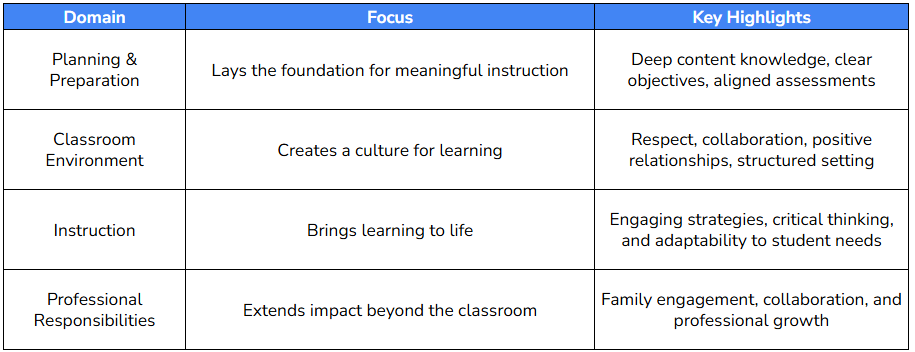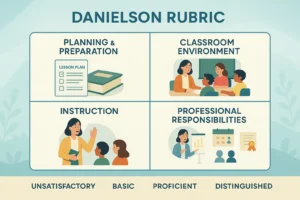Teaching is both an art and a science. Therefore, even the most dedicated educators benefit from clear guidance on how to grow.
The Danielson Rubric offers exactly that by providing a common language to reflect on practice. It’s a trusted framework to reflect on practice, improve instruction, and ultimately enhance student learning.
Key Takeaways
- The Danielson Rubric is a four‑domain framework: Planning & Preparation, Classroom Environment, Instruction, and Professional Responsibilities.
- Teacher performance is rated across four levels: Unsatisfactory, Basic, Proficient, and Distinguished. Each is guiding growth and reflection.
- While sometimes critiqued for complexity, the framework is widely adopted worldwide and has been shown to improve teaching quality and student outcomes.
Understanding the Danielson Rubric
The Danielson Rubric provides a clear and structured approach to identifying what effective teaching looks like. More than just an evaluation tool, it’s a guide for growth that encourages teachers to reflect on their practice and continuously improve.
To truly appreciate its potential, we must understand where it came from and how it has evolved.
The Origin and Development of the Danielson Framework

Charlotte Danielson introduced the Framework for Teaching in 1996 with the goal of offering a comprehensive, research‑based way to evaluate and support teachers.
Drawing inspiration from the Praxis III assessment, which is designed to evaluate first‑year teachers. The framework emphasized detailed observation and feedback as essential to professional growth.
Its release marked a significant shift in how schools approached teacher quality. By aligning closely with national teaching standards, the framework gave teachers and evaluators a shared language to discuss instructional practice.
Over the years, the framework has been refined to reflect new research and educational trends, ensuring it remains updated. This only ensures its continued relevance in today’s classrooms.
Purpose and Application of the Danielson Rubric
At its core, the Danielson Rubric serves two main purposes: evaluation and professional development.
Schools use it to assess teacher performance in a fair and structured way. However, equally important, teachers use it as a roadmap for growth.
By highlighting both strengths and areas for improvement, the teacher evaluation rubric empowers educators to engage in meaningful self‑reflection.
When paired with coaching and collaborative feedback, the framework encourages continuous improvement. Teachers who regularly reflect on their practice and seek feedback are better able to adapt instruction and meet diverse student needs.
The Four Domains of the Danielson Framework

The Danielson Framework is organized into four major domains, each capturing a critical aspect of teaching responsibility. Together, they paint a complete picture of what effective teaching entails.
Within each domain are specific components and elements. There are 22 in total that outline the finer details of practice.
Let’s look at each domain more closely.
Domain 1: Planning and Preparation
Strong instruction begins long before students enter the classroom.
This domain emphasizes the importance of teachers knowing their content deeply and understanding their students’ needs. It also looks at the design of lessons that align with meaningful learning goals.
Effective planning ensures that objectives are clear, assessments are purposeful, and instructional materials meet the needs of all learners.
Domain 2: The Classroom Environment
A positive classroom environment is essential for engagement and growth. This domain highlights the importance of respect, collaboration, and high expectations. Effective teachers intentionally build relationships with students while creating a culture of trust. They also effectively manage their classroom to promote active and cooperative learning.
Domain 3: Instruction
Instruction sits at the heart of teaching.
This domain focuses on how teachers deliver lessons that are engaging, rigorous, and adaptable to diverse learners. Effective instruction often includes open‑ended questioning, opportunities for critical thinking, and responsive adjustments to student needs.
Continuous reflection and refinement of teaching strategies make this domain dynamic and impactful.
Domain 4: Professional Responsibilities
Teaching extends beyond classroom walls.
This domain recognizes the importance of professionalism, collaboration, and lifelong learning. Teachers excel in this area by maintaining accurate records, engaging families, contributing to school culture, and staying current with evolving best practices. Ongoing professional development ensures they remain effective educators.

Performance Levels and Assessment Criteria

The Danielson Rubric doesn’t just outline what great teaching looks like. It also provides a roadmap for growth through four performance levels:
- Unsatisfactory
- Basic
- Proficient
- Distinguished
These levels represent increasing degrees of teaching effectiveness and serve as important guideposts for professional development.
Understanding Performance Levels
Each level reflects where an educator is in their professional journey:
- Unsatisfactory: Significant gaps in understanding or applying effective teaching practices.
- Basic: Partial or inconsistent application of strategies, showing promise but needing refinement.
- Proficient: Solid, consistent, and competent practice that reflects strong teaching skills.
- Distinguished: Exceptional and innovative practice, with consistent use of best strategies and leadership in advancing teaching quality.
Reflecting on these levels allows teachers to identify their current standing and set clear goals for moving forward. Progressing along these levels is not about judgment, but about supporting growth and improving outcomes for students.
Criteria for Evaluation
The framework’s strength lies in its detail: 22 components and 76 elements that capture the many facets of teaching. This thoroughness ensures evaluations consider the full scope of a teacher’s practice. Research has linked these principles with improved student outcomes, demonstrating their real‑world impact.
That said, some educators note that the rubric’s heavy focus on observable behaviors may not fully capture the complexities of pedagogy involved in evaluating teacher practice . Still, its research‑based design makes it a reliable and respected tool for assessing instructional quality.
Research-Based Foundation of the Danielson Framework

The Danielson Rubric rests firmly on decades of research about what makes teaching effective. It gives educators a shared language, a clear vision of high-quality teaching, and a supportive foundation for growth.
At its best, it inspires reflection, collaboration, and innovation.
Empirical Research on Effective Teaching
The framework has grown and adapted over time, integrating new priorities such as personalized learning and social-emotional development. These updates keep it relevant in today’s classrooms, ensuring it continues to align with evidence-based practices that improve student success.
Some argue that more direct links between rubric scores and teaching effectiveness would strengthen the framework’s credibility. Others point out that its complexity can feel daunting. Still, it provides a reliable structure, grounded in what works in classrooms.
Implementing the Danielson Framework in Schools
For districts and schools, the challenge is not only adopting the Danielson Framework but also using it effectively and fairly. Successful implementation requires intentional training, consistent application, and a culture of collaboration.
Training for Evaluators and Teachers
Strong implementation begins with thorough training. Evaluators must be well-versed in the rubric’s components to apply them consistently and fairly.
Teachers, in turn, need clarity on how the rubric works so that feedback feels constructive, not punitive. Because the framework can feel complex, schools should provide ongoing support and opportunities for collaboration.
Best Practices for Implementation
Best practices for introducing the Danielson Framework include engaging all stakeholders, teachers, leaders, and evaluators early in the process. Regular communication, feedback loops, and professional discussions create trust and clarity.
Using approaches such as Backward Design helps educators align lesson planning with desired learning outcomes, while incorporating differentiated instruction ensures lessons meet the needs of diverse learners.
Video observations and peer reflections can also enrich the process, offering teachers practical insight into their practice through real examples.
Modern Adaptations and Updates
Education never stands still, and neither does the Danielson Framework.
Effective teaching requires blending traditional methods with digital tools. The latest updates highlight the integration of technology to enhance student engagement and learning outcomes.
Whether through educational apps, online collaboration platforms, or multimedia presentations, technology can make lessons more interactive, accessible, and impactful.
For instance, Washington State has adopted the updated 2022 version of the framework, set to take effect in the 2025–26 school year. This reinforces the importance of adapting teacher evaluation to modern learning environments.
At Education Walkthrough, we’ve built on this very principle. Our classroom walkthrough software helps leaders and coaches give immediate, actionable feedback.
With customizable templates, instant sharing with teachers, and analytics to spot growth patterns, it makes professional learning more meaningful and connected. Trusted by leaders in more than 3,500 schools, it’s a simple way to turn observations into real professional growth.
{Insert CTA Block}
Global Impact and Adoption
The Danielson Framework has achieved widespread influence, shaping teacher evaluation and professional growth across the globe. Today, it is used in 49 U.S. states and in more than 15 countries, underscoring its flexibility and broad appeal.
Its adaptability allows it to fit into varied educational systems while keeping its core principles intact. This global adoption reflects a shared desire for fair, research-based evaluation methods that can improve teacher effectiveness and student outcomes.
Despite differences in implementation, the framework’s emphasis on reflection, growth, and observable practices has made it a reliable tool for elevating teaching quality in diverse contexts.
Integrating the Danielson Framework with Professional Development
The true strength of the framework emerges when it is integrated into professional development efforts. Rather than existing solely as an evaluation tool, it can be a catalyst for growth, reflection, and collaboration.
Using the Rubric for Self-Assessment and Reflection
Teachers often use the rubric to reflect on their own practice. By identifying strengths and areas for growth, they can set personal goals and monitor progress.
Keeping a reflection journal, for example, helps educators track insights over time and focus their professional learning more effectively.
This self-directed use of the framework nurtures a mindset of continuous improvement and ensures that growth is ongoing rather than tied to a single evaluation cycle.
Professional Conversations and Growth
The rubric also sparks meaningful professional conversations. When teachers discuss evidence from their classrooms using a common framework, collaboration becomes more purposeful. Shared reflections and feedback lead to new insights, improved strategies, and a culture of collective growth.
Ultimately, the Danielson Framework works best not as a checklist but as a conversation starter. One that encourages ongoing dialogue, mutual support, and professional learning communities.
Summary
The Danielson Framework provides a comprehensive and research-based approach to evaluating and strengthening teaching practices.
By encouraging reflection, collaboration, and continuous growth, the framework empowers educators to refine their practice while keeping student learning at the center.
As education evolves, the Danielson Framework remains a guiding light for nurturing professional excellence, providing valuable resources for supporting meaningful student outcomes.
Frequently Asked Questions
Have questions? We at Education Walkthrough are happy to help!
What is the Danielson Framework for Teaching?
The Danielson Framework for Teaching, developed by Charlotte Danielson, is a structured guide for evaluating and improving teaching practices, including essential documents for educators. It provides a comprehensive approach to assessing teacher performance and professional development.
When was the Danielson Framework published?
The Danielson Framework was published in 1996.
What was the purpose of the Praxis 3 assessment that influenced the Danielson Framework?
The Praxis 3 assessment served to evaluate first-year teachers through observations as a requirement for obtaining a continuing teaching license, thereby significantly influencing the development of the Danielson Framework. This framework reflects the standards necessary for effective teaching as identified through such assessments.
What is a common issue with the implementation of the Danielson Framework in some districts?
A common issue with implementing the Danielson Framework is that some districts adopt it in a top-down and punitive way, failing to transform the evaluation culture. This approach can hinder its effectiveness and acceptance among educators.
What advice does Charlotte Danielson give for ensuring effective observational evaluation?
To ensure effective observational evaluation, Charlotte Danielson emphasizes the importance of achieving consensus on what defines good teaching. This shared understanding is essential for accurate assessments and meaningful feedback.



